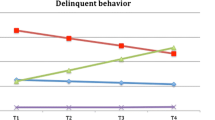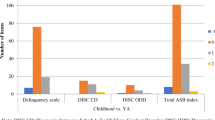Abstract
Two studies were conducted to test the hypotheses derived from Eysenck's and Gray's theories of personality regarding antisocial behavior. For this purpose the Eysenck Personality Questionnaire (Junior) (EPQ-Junior) and a card task aimed at measuring sensitivity to reward were used in each of the studies. The first study compared a group of juvenile delinquents with a group of nondelinquents and the second study compared a group of severely conduct-disordered children with a group of normal children. The results did not support Eysenck's claim that delinquents score higher than their normal counterparts on extraversion, neuroticism, and psychoticism. Some support was found for the hypothesis derived from Gray's theory: Children and adolescents with severe antisocial behavior were more sensitive to rewards than their normal counterparts.
Similar content being viewed by others
References
Allsopp, J. F., & Feldman, M. P. (1976). Personality and antisocial behavior in schoolboys.British Journal of Criminology, 16, 337–351.
American Psychiatric Association. (1980).Diagnostic and statistical manual of mental disorders (3rd ed.). Washington, DC: Author.
American Psychiatric Association. (1987).Diagnosis and statistical manual of mental disorders (3rd ed., rev.). Washington, DC: Author.
Arbuthnot J., Gordon, D. A., & Jurkovic C. J. (1987). Personality. In H. C. Quay (Ed.),Handbook of juvenile delinquency (pp. 139–183). New York: Wiley.
Brunner, J. S., & Goodman, C. C. (1947). Value and need as organizing factors in perception.Journal of Abnormal and Social Psychology, 42, 33–34.
Clarizio, H. F., & Veres, V. (1984). A short-form version of the WISC-R for the learning disabled.Psychology in the Schools, 21, 154–157.
Daugherty, T. K., & Quay, H. C. (1991). Response perseveration and delayed responding in childhood behavior disorders.Journal of Child Psychology and Psychiatry, 32, 435–461.
Eysenck, H. (1947).Dimensions of personality. London: Routledge and Kegan Paul.
Eysenck, H. J. (1964).Crime and personality. London: Routledge and Kegan Paul.
Eysenck, H. J., & Eysenck S. B. G. (1975).Manual of Eysenck Personality Questionnaire (Adult and Junior). London: Hodder and Stoughton.
Eysenck, H. J., & Eysenck, S. B. G. (1976).Psychoticism as a dimension of personality. London: Hodder and Stoughton.
Eysenck, H. J., & Gudjonsson, G. H. (1989).The causes and cures of criminality, New York: Plenum Press.
Farrington, D. P. (1991). Antisocial personality from childhood to adulthood.The Psychologist: Bulletin of the British Psychological Society, 4, 389–394.
Farrington, D. P., Biron, L., & Leblanc, M. (1982). Personality and delinquency in London and Montreal. In J. Gunn & D. P. Farrington (Eds.),Abnormal offenders, delinquency and the criminal justice system (pp. 153–201). New York: Wiley and Sons.
Fonseca, A. C. (1990).Conduct disorder in children and adolescents: An analysis of two models. Unpublished doctoral dissertation, Institute of Psychiatry, University of London, London, England.
Gabrys, J. B., Peters, K., Robertson, G., Utendale, K., Schump, D., Laye, R., O'Haire, T., Allard, I., & Phillips, N. (1988). Personality attributes of children with conduct disorders: The discriminant power of the Junior EPQ.Psychological Reports, 62, 63–69.
Gorenstein, E. E., & Newman, J. P. (1980). Disinhibitory psychopathology: A new perspective and model for research.Psychological Review, 87, 301–315.
Gray, J. A. (1970).Elements of a two-process theory of learning. New York: Academic Press.
Gray, J. A. (1972). The psychophysiological basis of introversion-extraversion: A modification of Eysenck's theory. In V. D. Nebylitsyn & J. A. Gray (Eds.),The biological bases of individual behavior (pp. 372–399). New York: Academic Press.
Gray, J. A. (1981). A critique of Eysenck's theory of personality. In H. J. Eysenck (Ed.),A model for personality (pp. 246–276). Berlin: Springer.
Gray, J. A. (1987).The psychology of fear and stress. Cambridge, England: Cambridge University Press.
Kalantari, M., Yule, W., & Gardner, F. (1991).Oversensitivity to reward in preschool conduct disordered children. (Manuscript submitted for publication).
Loeber, R., & Schmaling, K. B. (1985). The utility of differentiating between mixed and pure forms of antisocial child behavior.Journal of Abnormal Child Psychology, 13, 315–335.
Loeber, R., & Stouthamer-Loeber, M. (1987). Prediction. In H. C. Quay (Ed.),Handbook of juvenile delinquency (pp. 325–382). New York: Wiley.
Newman, J. P. (1987). Reactions to punishment in extraverts and psychopaths: Implications for the impulsive behavior of disinhibited individuals.Journal of Research in Personality, 21, 464–480.
Newman, J. P., & Kosson, D. S. (1986). Passive avoidance learning in psychopathic and nonpsychopathic offenders.Journal of Abnormal Psychology, 95, 252–256.
Newman, J. P., Patterson, C. M., & Kosson, D. S. (1987). Response perseveration in psychopaths.Journal of Abnormal Psychology, 96, 145–148.
Newman, J. P., Widon C. S., & Nathan, S. (1985). Passive avoidance in syndromes of disinhibition: psychopathy and extraversion.Journal of Personality and Social Psychology, 48, 1316–1327.
Perez, J. (1986). Teoria de Eysenck sobre la Criminalidad: El resultado de la investigation.Psiquis, VII, 35–61.
Powell, G. E. (1977). Psychoticism and social deviancy in children.Advances in Behavior Research and Therapy, 1, 27–56.
Powell, G. E., & Stewart, R. A. (1983). The relationship of personality to antisocial and neurotic behaviors as observed by teachers.Personality and Individual Differences, 4, 97–100.
Quay, H. C. (1988). The behavioral reward and inhibition systems in childhood behavior disorders. In L. M. Bloomingdale (Ed.),Attention deficit disorder: New research in treatment, Psychopharmacology and Attention. (Vol. 3 pp. 176–186). New York: Pergamon.
Quay, H. C. (1987). Patterns of delinquent behavior. In H. C. Quay, (Ed.),Handbook of juvenile delinquency (pp. 106–117). New York: Wiley.
Quay, H. C., & Peterson, D. R. (1987).Manual for the Revised Behavior Problem Checklist. Coral Gables, FL: Authors.
Robins, L. N. (1966).Deviant children's grown up. Baltimore: Williams & Wilkins.
Rutter, M. (1967). Children's behavior questionnaire for completion by teachers.Journal of Child Psychology and Psychiatry, 8, 1–11.
Rutter, M., & Giller, H. (1983).Juvenile delinquency: Trends and perspectives. New York: Penguin Books.
Scerbo, A., Raine, A., Obrien, M., Chan, Ch., Ree, C., & Smiley, N. (1990). Reward dominance passive avoidance learning in adolescent psychopaths.Journal of Abnormal Child Psychology, 18, 451–463.
Schachar, R., & Logan, G. (1990). Impulsivity and inhibitory control in normal development and childhood psychopathology.Developmental Psychology, 26, 710–720.
Shapiro, S., Quay, H., Hogan, A., & Schwartz, K. P. (1988). Response perseveration and delayed responding in unsocialized conduct disorder.Journal of Abnormal Psychology, 97, 371–373.
Tennenbaum, D. J. (1977). Personality and criminality: A summary and implications of the literature.Journal of Criminal Justice, 5, 225–235.
Wechsler, D. (1974).Manual for the Wechsler Intelligence Scale for Children-Revised. New York: Psychological Corporation.
World Health Organization. (1978).Mental disorders: Glossary and guide to their classification. Geneva: Author.
Author information
Authors and Affiliations
Rights and permissions
About this article
Cite this article
Fonseca, A.C., Yule, W. Personality and antisocial behavior in children and adolescents: An enquiry into Eysenck's and Gray's theories. J Abnorm Child Psychol 23, 767–781 (1995). https://doi.org/10.1007/BF01447476
Received:
Issue Date:
DOI: https://doi.org/10.1007/BF01447476




